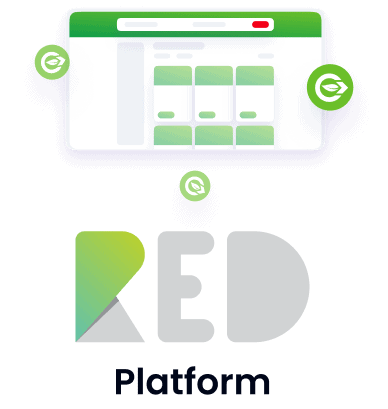We aim to democratize and digitize the voluntary carbon market. Obtaining RED certification gives sustainable actions and green projects our environmental seal of approval, visibility, accountability, marketing and promotion of their ESG actions.
Get StartedRED Carbon StandardPrinciples
RED Carbon Standard meets the ICVCM Principles
Additionality
Mitigation
activity
information
No double
counting
Permanence
Program
governance
Registry
Robust independent third-party validation and verification
Robust quantification of emission reduction and removals
Sustainable development impacts and safeguards
Transition towards
net-zero emissions
Start Exploring
Additional Principles RED Carbon Standard
Value for all
Users
Engagement
Governance and Decentralization based on proof of stake
Security
and Validation
Global
Integrated System
Accountability
Transparency
Cost-Effectiveness
Open Dialogue
Inclusion
Discover RED Carbon Standard
CoveredSectors
The Projects registered under the RED Carbon Standard shall meet the International Panel for Climate Change emission categories, as follows:
Energy industries
renewable / non-renewable sources
Chemical industries
Fugitive emissions from fuels
solid, oil and gas
Energy distribution
Construction
Fugitive emissions
from halocarbons and sulphur hexafluoride
Energy demand
Transport
Waste handling and disposal
Manufacturing industries
Mining/mineral production
Afforestation and reforestation
Chemical industries
Metal production
Agriculture
Zalmoxis Blockchain
RED Platform’s Zalmoxis blockchain is available for users’ consultation by searching for blocks, addresses and transactions.
Start Exploring
Advantages
Energy saving enabled for processing the transactional blocks by switching to POR (Proof of Reputation).
Using a trusted network of authoritative company-owned nodes means that there will be no traditional mining needed and no wasted energy.
For security and transparency, every 24 hours, an encrypted hash will be registered on the public Ethereum network with all internal transactions on RED.

Transparency
All actions registered on the RED Registry, projects, purchases, etc. remain recorded on the blockchain. The information is available for verification.

Untemperability
The information registered on the blockchain cannot be altered or modified. Accuracy, precision and traceability are extremely important in the process.

Integration with third parties
Blockchain technology allows for faster and more accurate integration of the registry with other interested parties, as well as for future cooperations between interested parties.

NFTs can be sold anywhere
All information is represented andlay between the retirement of credits and the registration of the action on the blockchain.

The RED Carbon Standard uses the RED Platform for the certification process and carbon credits issuance and management.
Owns its blockchain Zalmoxis (private Ethereum)
Records internal transactions without gas costs in a network with nodes in each country with existing franchises
shapes their own vision and tools using both legacy and modern features along the way
Smart contracts are used inside the blockchain to minimize human error and speed the carbon credit issuing process
Blockchain speed was increased by moving to PoR. Our test and main net can support a continuous load of 1,100 transactions per second
The point of encounter for project developers, corporate and individual clients through online access and our franchised partners:
Users can calculate, receive tokens for their sustainable actions
offset their carbon footprint with published sustainable projects
RED Franchises offer carbon footprint calculation and offsetting to their corporate clients
Having your carbon credits listed on the platform will gain visibility, earn more trust from interested customers and partners and develop your business.

Blockchain Technology
Applied to processes that already exist to transform the certification process into a transparent flow that helps identify the step in which a project is, without the possibility of change.
Learn moreTechnology
RED Standard supports ICVCM Principles
Start Exploring
Cost-Effectiveness
The standard is accessible to companies who promote and implement sustainable projects without any discrimination, with flexible payment.
Learn more

Inclusion
Project developers are encouraged to submit their projects for validation and registration within their local communities.
Learn more
Accountability
Accountability for the green actions performed on the RED platform will be always and foremost transparent and accessible on the blockchain.
Learn more
Transparency
The opportunity for companies to choose, select and decide where their offset goes and see the entire process accomplished is offering a unique value to the project.
Learn more
Security and Validation
Transparency, traceability, and validation of tokenized carbon credits claims offer the RED carbon offset system a perfect structure for trustworthy transactions.
Learn more
Global Integrated System
A safe, trustworthy, scalable, easy-to-use system for tracking and rewarding CO2 carbon credits to companies and individuals available at all times.
Learn more
Governance and Decentralization based on proof of stake
The RED community will be able to vote on the RED-certified carbon projects and CO2 offset schemes created by users.
Learn more
Value for all Users
By accounting for variables impacting our climate, our users will become environmentally conscious, which represents small, but essential steps to reaching carbon neutrality on a global scale.
Learn more
Engagement
We aim for engagement with all types of stakeholders in order to help them to grow and develop new sustainable projects through the RED Franchise system.
Learn moreRED Blockchain
Carbon Standard Registry

Smart contracts and NFT solutions
Smart contracts and NFT solutions applied to tokenized carbon credits and RED-validated projects are secured on the Ethereum blockchain.

Carbon credits can be tracked
The carbon credits can be tracked and have only one owner at a time.

Each NFT is unique
Each NFT is unique and they are compatible with other systems built on Ethereum blockchain platforms.

NFTs can be sold anywhere
NFTs can be sold anywhere, and the owners have access to the global market.
Data such as project ID and name, the status of the project, SDGs, number of tokenized carbon credits issued, burnt and remaining will be accessible through the RED Registry explorer that will automatically present a project’s information or tokenized carbon credit status based on registered information on the blockchain.
Through the RED Carbon Standard Registry, RED Platform is also pioneering the way for other blockchain and standard sustainability-related companies to have access to the carbon credits issued under the RED Standard. The carbon credits management system will allow access to and from other blockchains, as well as allow other platforms to sell carbon credits on their websites even without blockchain technology.
Start Exploring
Sustainability
We would like to give the new generations a better home to live in, and we consider that this is linked not only to environmental protection or ESG criteria but to maintaining the principles of life and its continuity. If all these principles are called by science sustainable actions, then we do believe in sustainability.
Read the complete RED Carbon Standard:
RED Carbon Standard